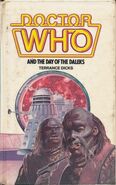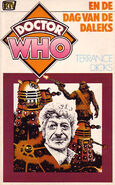Vincent VG (talk | contribs) |
Vincent VG (talk | contribs) |
||
| Line 116: | Line 116: | ||
* Published in the Netherlands by Unieboek/De Gooise in about 1975/76 as a paperback edition, translated by FF van der Hulst-Brander and published as ''Doctor Who en de Dag van de Daleks'', it was one of eight Dutch novelisations; despite the broadcaster TROS showing [[Season 12|Seasons 12]] and [[Season 13|13]] at this time the cover still depicts the [[First Doctor]], however [[Chris Achilleos]]' image of the [[Fourth Doctor]] from [[The Doctor Who Monster Book]] does appear on the back cover.<ref>{{cite web|url=https://www.wonderfulbook.co.uk/basedon/|title=Based on the Popular BBC Television Serial 3rd Edition}}</ref> |
* Published in the Netherlands by Unieboek/De Gooise in about 1975/76 as a paperback edition, translated by FF van der Hulst-Brander and published as ''Doctor Who en de Dag van de Daleks'', it was one of eight Dutch novelisations; despite the broadcaster TROS showing [[Season 12|Seasons 12]] and [[Season 13|13]] at this time the cover still depicts the [[First Doctor]], however [[Chris Achilleos]]' image of the [[Fourth Doctor]] from [[The Doctor Who Monster Book]] does appear on the back cover.<ref>{{cite web|url=https://www.wonderfulbook.co.uk/basedon/|title=Based on the Popular BBC Television Serial 3rd Edition}}</ref> |
||
* Published in the USA by Aeonian Press in 1978 as a hardback edition; despite this being only one of two novelisations published in the 1970's Aeonian Press would republish this and publish a further six novelisations in the mid-1980's. |
* Published in the USA by Aeonian Press in 1978 as a hardback edition; despite this being only one of two novelisations published in the 1970's Aeonian Press would republish this and publish a further six novelisations in the mid-1980's. |
||
| − | * Published in the USA by Pinnacle Books in 1979 as a paperback edition, it was one of ten American novelisations; an introduction by Harlan Ellison features in all the editions. |
+ | * Published again in the USA by Pinnacle Books in 1979 as a paperback edition, it was one of ten American novelisations; an introduction by Harlan Ellison features in all the editions. |
* Published in Japan by Hayakawa Bunko in 1980 as a paperback edition, translated by Yukio Sekiguchi and published as ''Darek Zoku no gyakushuu!'', it was one of five Japanese novelisations. |
* Published in Japan by Hayakawa Bunko in 1980 as a paperback edition, translated by Yukio Sekiguchi and published as ''Darek Zoku no gyakushuu!'', it was one of five Japanese novelisations. |
||
* Published in Portugal by Editorial Presença in 1983 as a paperback edition, translated by Conceicao Fardim and Eduardo Nogueira and published as ''Doutor Who e o Dia dos Daleks'', it was one of ten Portuguese novelisations. |
* Published in Portugal by Editorial Presença in 1983 as a paperback edition, translated by Conceicao Fardim and Eduardo Nogueira and published as ''Doutor Who e o Dia dos Daleks'', it was one of ten Portuguese novelisations. |
||
Revision as of 17:47, 12 September 2019
Doctor Who and the Day of the Daleks was a novelisation based on the 1972 television serial Day of the Daleks. In 1979, this book was chosen as the inaugural release of the first (and to date only) American-published series of Doctor Who novels by Pinnacle Books. Over the next few years, ten novelisations would be republished in the US, each with an introduction by Harlan Ellison.
Publisher's summary
1974 edition
Mysterious humans from 22nd-century Earth `time-jump' back into the 20th century so as to assassinate a high-ranking diplomat on whom the peace of the world depends. DOCTOR WHO, Jo Grant and the Brigadier are soon called in to investigate. Jo is accidentally transported forward to the 22nd century; the Doctor follows, eventually to be captured by his oldest and deadliest enemy – the DALEKS! Having submitted the Doctor to the fearful Mind Analysis Machine, the DALEKS plan a `time-jump' attack on Earth in the 20th century! ...
Chapter titles
- Terror in the Twenty-Second Century
- The Man Who Saw a Ghost
- The Vanishing Guerilla
- The Ghost Hunters
- Condemned to Death!
- Prisoner of the Daleks
- Attack of the Ogrons
- A Fugitive in the Future
- Escape from the Ogrons
- Interrogation by the Daleks
- The Raid on Dalek Headquarters
- Return to Danger
- The Day of the Daleks
- All Kinds of Futures
Deviations from televised story
- All of Chapter One, set in the Dalek-controlled 22nd century, is original to the novel. Numerous previously unnamed rebels are named here.
- Auderly House is named Austerly House, to avoid confusion with the real life Auderly House.
- While Anat has long hair on the televised version, she is described and illustrated as having short hair here. However, her hair on television is at most shoulder length and, while not accurately depicting her bouffant, the hair in the illustrations is not much longer.
- In chapter 2, Reginald Styles fights back against his attacker and UNIT glimpses the Ogrons earlier. ("Between The Lines", a feature in the 2012 reprint, notes that the Brigadier and Benton ignore this sighting and follow the script's focus on "ghost" instead, although this is an exaggeration since the encounter is mentioned many times and UNIT are merely following the only lead open to them.)
- When the second guerrilla is chased by the Ogrons through the grounds, Sergeant Benton and several other soldiers notice and start firing at the Ogrons. No such fight takes place on-screen.
- When the Ogrons attack the house for the first time, the UNIT soldiers gather around to create a barrier of defence and fight back.
- The Doctor's wrists are said to be bleeding after he cuts the ropes tying his hands together in Styles' wine cellar.
- A Black Dalek is included and it takes up most of the original Gold Dalek's tasks. The Gold Dalek appears halfway through the novel, and the Black Dalek acts as its second-in-command. Terrence Dicks invents a Dalek High Council that rules Earth.
- The Brigadier gives more information on the international crisis, explaining that China, Russia and the USA are all involved and it began in the "Near East" (contemporary term for Middle East).
- The Doctor reminds the Daleks that he defeated them on Skaro in The Evil of the Daleks, which he believed to be "the final end". Strangely, however, the cut scene in which the Daleks explain that they defeated the Humanised Daleks in the Dalek Civil War is absent here as well.
- Instead of a luxurious meal, the Controller and Jo eat "coarse bread, tough meat, and a mish-mash of strange vegetables" (chapter 9). This is considered a luxury in the Controller's time.
- The final chapter of the novel, where the Doctor and Jo meet their past selves, isn't included in the TV version. The scene was written, but director Paul Bernard refused to film it, saying "Once it's over, it's over." It was cut from the finished programme.
- Monia is renamed Moni.
- The TARDIS is in the corner of the Doctor's laboratory, rather than the console being removed. The Doctor tests the disintegrator gun on a dummy rather than using a futuristic testing range.
- Styles leaves Austerley after his first meeting with the Doctor and the Brigadier, rather than still being present when the guerrilla is found.
- The guerrilla disappears from the UNIT sickbay rather than an ambulance. Anat states two men have tried to kill Styles before them: On screen, they are the same person.
- The Doctor ungags Jo rather than letting her work the gag loose herself.
- Anat is more helpful when the Doctor is transported back in time, explaining the situation on Earth and telling him where Jo will be.
- The manager identifies himself to the Doctor as a member of the resistance before the Controller interrupts them.
- Instead of being killed outright by the Ogron, Moni says the manager was killed by a firing squad.
- The guard who interrogates the Doctor is not identified as the Senior Guard.
- The Doctor knocks out an Ogron at Austerley by banging its head against a wall, later realising the top of the head is a weak point.
- The Doctor attacks a guard at the factory for whipping a slave before being captured.
- The Ogrons who pursue the Doctor and Jo are on motorised tricycles like their own. Also, the tricycle chase scene is longer than it is in the televised story.
- Three guerrillas named Mark, Joab and Zando take part in the attack on Dalek Control to rescue the Doctor. On-screen, only Mark is mentioned.
- It is explained that the Ogrons killed by UNIT disappeared, depriving the Brigadier of evidence.
- The Brigadier twice calls Yates "Mike", something that does not happen in this serial and rarely happens in others.
- More detail is given into how Shura avoids the UNIT patrols.
- The Controller is arrested by his assistant, Zeno, under orders from the Daleks, rather than being betrayed by the senior guard from earlier in the serial.
- Anat accompanies the Doctor and Jo into the tunnel, escaping when the Controller is arrested.
Writing and publishing notes
to be added
Additional cover images
Cover by Andrew Skilleter
Cover by Alister Pearson
British publication history
First publication:
- Hardback
- W.H. Allen & Co. Ltd. UK
- Paperback
- Target Block Logo / Orange lettering for title
Re-issues:
- 60p (UK) Diamond-based Logo / brown lettering for title
- 1982 Target Books with a new cover by Andrew Skilleter priced (UK)
- 1991 Virgin Publishing with a new cover by Alister Pearson priced (UK)
Editions published outside UK
- Published in Brazil by Global Editoria e Distribuidora in 1974/75 as a paperback edition, translated by Marcio Pugiliesi and Norberto de Paula Lima and published as Doutor Who e a Mudança da História, it was the only Brazillian novelisation published; despite the book being dated 1974 the cover artwork is signed 'Darlon 75' so it may not have been published until the following year.[1]
- Published in Turkey by Remzi Kitabevi in 1975 as a paperback edition, translated by Reha Pinar and published as Doktor Kim ve Dalek Baskini, it was one of six Turkish novelisations.
- Published in the Netherlands by Unieboek/De Gooise in about 1975/76 as a paperback edition, translated by FF van der Hulst-Brander and published as Doctor Who en de Dag van de Daleks, it was one of eight Dutch novelisations; despite the broadcaster TROS showing Seasons 12 and 13 at this time the cover still depicts the First Doctor, however Chris Achilleos' image of the Fourth Doctor from The Doctor Who Monster Book does appear on the back cover.[2]
- Published in the USA by Aeonian Press in 1978 as a hardback edition; despite this being only one of two novelisations published in the 1970's Aeonian Press would republish this and publish a further six novelisations in the mid-1980's.
- Published again in the USA by Pinnacle Books in 1979 as a paperback edition, it was one of ten American novelisations; an introduction by Harlan Ellison features in all the editions.
- Published in Japan by Hayakawa Bunko in 1980 as a paperback edition, translated by Yukio Sekiguchi and published as Darek Zoku no gyakushuu!, it was one of five Japanese novelisations.
- Published in Portugal by Editorial Presença in 1983 as a paperback edition, translated by Conceicao Fardim and Eduardo Nogueira and published as Doutor Who e o Dia dos Daleks, it was one of ten Portuguese novelisations.
- Published in Poland by Empire Books in 1994 as a paperback edition, translated by Andrzej Solny and published as Doctor Who - Dzień Daleków, it was one of three Polish novelisations.
Cover by David Mann
Audiobook
This Target Book was released 10 November 2016 complete and unabridged by BBC Physical Audio and read by Richard Franklin with Dalek voices by Nicholas Briggs.
The cover blurb and thumbnail illustrations were retained in the accompanying booklet with sleevenotes by David J. Howe. Music and sound effects by Simon Power.
External links
to be added














